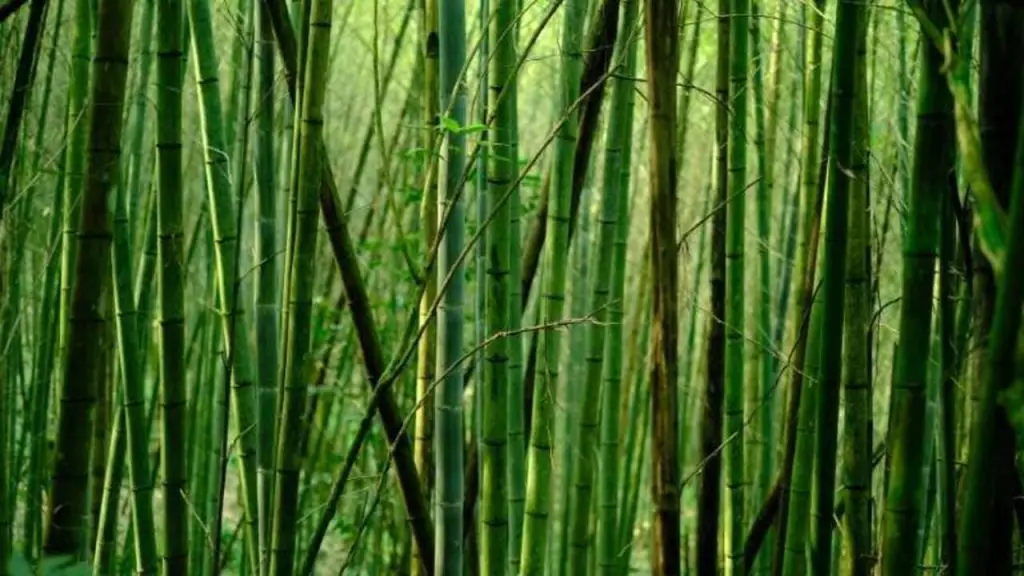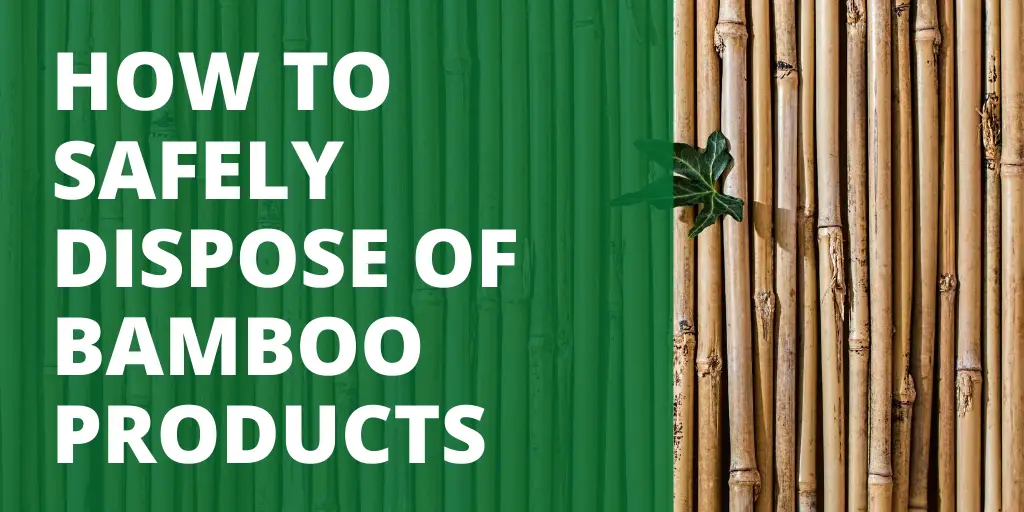For an eco-friendly plastic alternative, lots of people are turning to bamboo products, like bamboo toothbrushes. Bamboo is biodegradable and good for the environment, and often it can also be ethically sourced.
Bamboo products are great to have because when their product life is over in your home, they can be disposed of easily. We’ll go over how to safely dispose of bamboo products without harming the environment.
With a few simple steps, you can make sure you’re putting your bamboo product in the right place when disposing of it.
Types of Bamboo Products and their Environmental Impact
Bamboo is a versatile material used to make various products, including furniture, flooring, textiles, and kitchenware. While bamboo is generally considered an eco-friendly material, some products may have a more significant environmental impact.
For example, bamboo products that are chemically treated or contain synthetic materials may not be as sustainable as those that are made from natural, organic bamboo.
It’s essential to consider the environmental impact of the bamboo products you purchase and dispose of them to minimize harm to the planet.
When shopping for bamboo products, look for those certified by organizations such as the Forest Stewardship Council (FSC) or the Sustainable Forestry Initiative (SFI) to ensure they are sustainably sourced and produced.
DISPOSE OF BAMBOO PRODUCTS

1. Recycle Your Bamboo Products
Recycling is one of the most effective ways to dispose of bamboo products. You can recycle bamboo products, but it is essential to ensure they are adequately cleaned and prepared before being sent to a recycling facility.
Here’s how to recycle bamboo products:
- Clean the bamboo product: Before recycling it, ensure it is clean and free of any debris or contaminants. Use soap and warm water to clean the product thoroughly.
- Separate any metal components: If your bamboo product has any metal components, such as screws or hinges, remove them and separate them from the bamboo.
- Check with your local recycling facility: Not all recycling facilities accept bamboo products, so it’s essential to check with your local facility first. If they do buy bamboo products, follow their guidelines for recycling.
Toothbrush company Brush with Bamboo explains how to dispose of a bamboo toothbrush or other bamboo product:
“You may remove the bristles from the head of the toothbrush – this will also remove the metal staples holding the bristles into the handle. Aluminum is not biodegradable but it will break down through chemical reactions in the environment. Aluminum is also highly recyclable. 75% of all aluminum ever produced is still in use today.”
2. Compost Your Bamboo Products
Another effective way to dispose of bamboo products is by composting. Bamboo is a natural material that can break down quickly in a compost pile.
Here’s how to compost bamboo products:
- Cut the bamboo product into smaller pieces: To help the bamboo break down more quickly, cut it into smaller pieces before adding it to the compost pile.
- Mix with other compostable materials: Add the bamboo pieces to your compost pile and mix them with other compostable materials, such as food scraps, leaves, and grass clippings.
- Keep the pile moist and well-aerated: To help the compost break down more quickly, keep the rise moist and well-aerated. Turn the bank regularly to ensure that it is well-mixed.
Eco-friendly company Bamwoo highlights here how long it takes for bamboo to break down depending on the environment:
- “If you just throw a bamboo toothbrush into your garden, it might take as long as 5-10 years to fully break down.
- Buried horizontally in the soil, it will take around 3 years
- A home composter should take around 4-6 months (depending on composition). You can speed this up by breaking the toothbrush down into small pieces with a hammer or saw.
- An industrial composter should break a toothbrush down in a few weeks (they are much hotter and more active than any home composter).”
3. Donate or Reuse Your Bamboo Products
If your bamboo product is still in good condition, consider donating it or finding a new use. Here are some ideas:
- Donate to a local charity or thrift store: Many charities and thrift stores accept donations of bamboo products.
- Repurpose the bamboo product: Bamboo products can be repurposed in various ways, such as using bamboo utensils as plant stakes or bamboo cutting boards as serving trays.
- Sell the bamboo product: If your bamboo product is in good condition, consider selling it online or at a garage sale.
4. Preserve Your Bamboo for Longer
It may be compostable, but you can still try to preserve your bamboo product for longer to avoid buying a replacement.
When bamboo is made into a consumer product, it’s meant to be stored in a dry and cool place. Try to keep it out of humid areas that could cause it to decompose.
If you have a bamboo toothbrush or other bamboo bathroom product at home, The Humble Co has this recommendation to preserve it for a longer time:
“Bamboo is a material that will keep best when stored dry, which is why enclosed toothbrush cups that may collect water are not recommended. We recommend that you keep your toothbrush in an open-air toothbrush holder or other dry area.”
Tips for Reducing Waste when Using Bamboo Products
In addition to proper disposal, there are several ways to reduce waste when using bamboo products. Here are some tips:
- Choose durable bamboo products: High-quality bamboo products are more durable and can last longer, reducing the need for frequent replacement.
- Avoid disposable bamboo products: While disposable bamboo products like utensils and plates may be convenient for outdoor events, they create unnecessary waste. Instead, choose reusable bamboo products that can be washed and used again.
- Repair rather than replace: If your bamboo product gets damaged, try repairing it rather than throwing it away. Minor repairs like sanding or re-oiling can often extend the life of bamboo products.
Sustainable Alternatives to Bamboo Products
While bamboo is a sustainable material, other options are available for those who want to reduce their environmental impact. Here are some eco-friendly alternatives to bamboo products:
- Stainless steel: Stainless steel is a durable and long-lasting material used to make various products, including kitchenware, water bottles, and straws.
- Glass: Glass is another sustainable material for making products like containers, drinking glasses, and vases.
- Wood: Like bamboo, wood is a renewable resource for making various products, including furniture, cutting boards, and utensils.
Benefits of Disposing of Bamboo Products
Once upon a time, a family loved to use bamboo products in their daily lives. Their home had bamboo utensils, cutting boards, and even bamboo flooring. But they never considered what would happen to these products when they were unusable.
One day, their bamboo cutting board had become so worn out that it was no longer safe. The family was unsure what to do with it, so they left it in the garage for a few weeks. Eventually, they realized that they needed to dispose of it properly.
They researched and discovered that bamboo products could be recycled or composted, which would help reduce waste and protect the environment. They learned that bamboo is a renewable resource that proliferates and can be harvested sustainably.
By properly disposing of their bamboo cutting board, they were doing their part to ensure that this valuable resource was not wasted.
The family also learned other ways to dispose of their bamboo products. They could donate them to local organizations or charities that could use them or repurpose them into something new.
For example, their old bamboo cutting board could be turned into a birdhouse or a decorative wall hanging.
As the family continued using and disposing of their bamboo products responsibly, they noticed they positively impacted the environment. They were reducing waste, conserving resources, and helping to create a more sustainable future.
In the end, the family realized that disposing of bamboo products properly wasn’t just about getting rid of something old or worn out.
It was about being mindful of their environmental impact and taking steps to reduce that impact.
By doing so, they were helping to create a better world for themselves and future generations.
The Bottom Line
Safe disposal of bamboo products is just one aspect of sustainable living. By choosing durable products, reducing waste, and considering alternative materials, we can all do our part to protect the environment.
Whether you recycle, compost, donate, or repurpose your bamboo products, remember that every small action counts towards making our planet cleaner and healthier.
FAQs
How long does it take for bamboo products to biodegrade?
Bamboo products can take a few months to several years to biodegrade, depending on various factors such as the product’s thickness and environmental conditions.
Generally, bamboo products will break down faster than plastic but slower than organic materials like food waste.
Does burning bamboo release toxins?
Burning bamboo releases carbon dioxide and other air pollutants, including carbon monoxide and volatile organic compounds (VOCs), which can harm human health and the environment.
It’s not recommended to burn bamboo or any other materials.
Is bamboo shoot carcinogenic?
No, bamboo shoot is not carcinogenic. It is considered to be a healthy and nutritious food.
Additional Posts:

